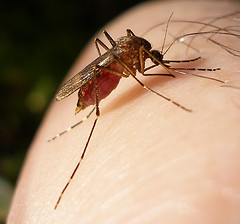Don’t Let an Insect Bite Ruin Your Health on Your Next Vacation or Business Trip
5 March 2012
The list of mosquito- and tick-borne diseases is populated with really scary ones. Some of these diseases pose only short-term risks and discomfort, but others can cause serious, long-term damage and even death.
While you may not encounter these insects where you live, you can encounter them when you travel, and so it’s important to understand your risks and implement proper prevention techniques.
Mosquito- and Tick-borne Diseases You May Encounter While Traveling
The following are known diseases spread by mosquitoes:
- Dengue Fever – recognized as a global plague that may soon eclipse malaria, this is the most significant mosquito-borne viral illness affecting humans and is especially dangerous to children. Symptoms may include internal bleeding, shock, and a collapse of the circulatory system.
- Encephalitis – with a 30-60% mortality rate once contracted, this disease causes severe damage to the central nervous system (if you survive, that is).
- Malaria – as high as 40% of the world’s population is at risk and it claims over a million lives each year. Symptoms include fever, chills, head and muscle aches, and loss of energy.
- West Nile Virus – the symptoms are fever, headache, nausea, vomiting and rash as well as stiffness, disorientation, vision loss and more. While only 20% of people who contract it show symptoms, they could last weeks and even be permanent.
- Yellow Fever – with no specific treatment, other than symptom relief, this disease can still be fatal. Symptoms include fever, head and back ache, nausea and vomiting, and in severe cases it can affect the liver and kidneys.
According to WebMd.com, common tick-borne diseases include:
- Lyme disease
- Rocky Mountain spotted fever
- Tuleremia
- Ehrlichiosis
- Relapsing fever
- Colorado tick fever
- Babesiosis
Preventing Mosquito and Tick Bites 101
The first rule for tick and mosquito bite prevention is to avoid getting bitten. To accomplish that, you have a number of steps you can implement including recognizing, avoiding, and even removing their preferred habitats:
- Tick habitats are in and near tall grass, shrubs, and trees. Removing tick habitats involves reducing leaf litter and mowing tall grass.
- Mosquito habitats are in and near standing water. Remove water from old tires, buckets, toys and clear rain gutters to ensure mosquitoes can’t breed.
Avoiding tick bites
- Cover your skin with long-sleeved shirts, pants, and high boots.
- Cover gaps in clothing by tucking your shirt into your pants and pants into your boots.
- Walk in the center of trails to avoid contact with surrounding plants.
Avoiding mosquito bites
- Cover your skin with long-sleeved shirts, long pants, and socks.
- Cover gaps in clothing.
- Stay indoors at sunrise, sunset, and early evening – when mosquitoes are most active.
- Install and/or repair screens and netting over sleeping areas.
In addition to the above, careful application of insect repellent is also advised, especially when you can’t avoid the insect habitats, i.e. you’re on a camping trip, or boating on a lake, or hiking through a forest.
5 Rules for Safe Insect Repellent Use
Using the right insect repellent can discourage ticks, mosquitoes, and other biting insects from landing on you. The EPA recommends you always read the product label before purchasing and using the product because precautions about the product’s use on pregnant or lactating women, or on children, will be on the label. In all cases, you should keep insect repellent products away from your eyes.
In addition to the above, the safest use of insect repellent involves these steps:
- Apply repellent products only to exposed skin and clothing. It’s not necessary to use it under your clothing as that’s protection already.
- Never use repellent on skin that is wounded or irritated.
- If using a spray, do it in a non enclosed area and never near food or drinks.
- When applying repellent to the face and neck, apply first to your hands and then rub on your face, neck and ears.
- Wash the repellent off with soap and water as soon as you are back indoors.
3 Rules for Safe Insect Repellent Use on Kids
Because children frequently put their hands in their mouth and use their hands to rub their eyes, the following precautions are recommended when applying insect repellent to kids:
- Do not allow children to handle the repellent and do not apply it to their hands.
- Put the repellent on by applying it to your hands and then putting it on the child.
- After returning indoors (away from insects), wash the child’s skin and clothing thoroughly.
Check out these related topics
- Check the traveler’s health reports for your destination before you travel – this way you’ll know your risk of malaria, yellow fever, etc.
- Know what to do if you do get sick on your trip – when it’s serious, who to call, and how to locate local medical help
- See the current CDC recommendations for protection against mosquitoes, ticks, and other insects
Damian Tysdal is the founder of CoverTrip, and is a licensed agent for travel insurance (MA 1883287). He believes travel insurance should be easier to understand, and started the first travel insurance blog in 2006.

